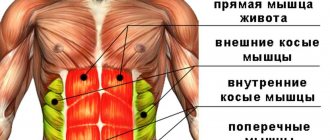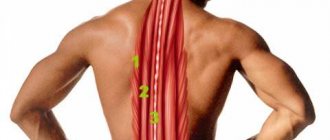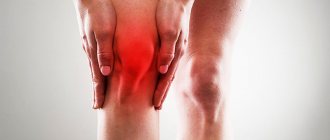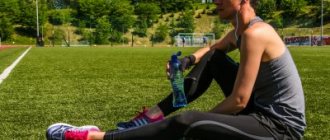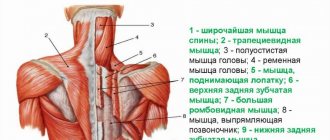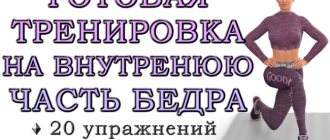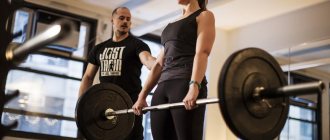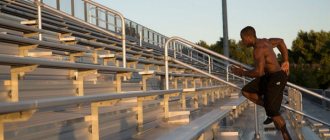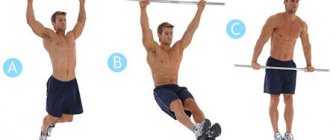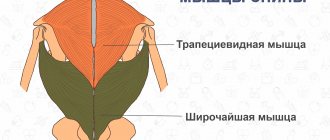Author
: Grachev Ilya Illarionovich
Editor
: Efremov Mikhail Mikhailovich
Date of publication: 30.11.2020 Date of update: 18.03.2021 All doctors of the clinic
- Severe back pain due to coronavirus and other acute respiratory viral infections
- Osteochondrosis and disc herniation
- Drug therapy
What to do if severe back pain suddenly appears, how to relieve the pain and can you do it yourself? Of course, it’s good to know how to help yourself in case of sudden severe pain, but you shouldn’t limit yourself to this: after the first emergency self-help, you should immediately consult a doctor. At the Moscow Paramita clinic they will always help you: they will determine the cause of the pain and get rid of it.
What to do for acute back pain
Back pain occurs periodically in 60-80% of the population. This is the second most common cause of temporary disability after acute respiratory viral infections. Acute back pain can begin suddenly and end just as suddenly, but it can subside slightly and become chronic. This should not be tolerated; it is better to seek medical help immediately.
Just don't panic
The appearance of severe back pain does not mean that a person cannot be helped; in most cases, all this can be successfully treated, which means there is no need to panic. But it is important to know how to help yourself and reduce pain, and then immediately consult a doctor. Contacting a specialist is necessary, since back pain is caused by many diseases and they require different approaches to treatment.
How to alleviate your condition yourself
Sometimes the pain syndrome is so severe that the person remains in the position in which the attack caught him. In this case you need:
- Lie on your back on a hard surface, or on the floor, with a blanket on it; if you can’t straighten your back, then you need to take a position that causes minimal pain.
- Ask your loved ones to give a tablet of any painkiller (Analgin, Paracetamol, Diclofenac, Ibuprofen, Nise, etc.), all of them can be bought at the pharmacy without a prescription:
- Diclofenac
is the most effective drug from the group of nonsteroidal anti-inflammatory drugs (NSAIDs); in emergency cases, it is better to use 100 mg rectal suppositories - the drug is instantly absorbed in the rectum and begins to act; contraindicated for diseases of the gastrointestinal tract (GIT), as it inhibits the effect of substances that protect the gastrointestinal mucosa from any unwanted effects; - Nise (nimesulide)
is a more modern drug from the NSAID group, has virtually no negative effect on the gastrointestinal tract, but is less effective than Diclofenac; for acute pain, you can take a 100 mg tablet; - Analgin (metamizole)
is a pain reliever; for severe pain, you can take a 500 mg tablet; Be careful: you should not take this medicine often, it gives many side effects. - Apply any pain-relieving drug for external use to the skin over the painful area: Menovazin rubbing solution, Diclofenac ointment, Pentalgin gel, Voltaren emulgel and other over-the-counter drugs:
- Menovazin
- a solution for rubbing contains two substances with a local anesthetic effect (procaine, benzocaine) + a local irritant and vasodilator menthol; the solution is applied to the skin and rubbed 2 – 3 times a day; - Diclofenac ointment and Voltaren emulgel
- contain the active substance diclofenac, which has a local anesthetic effect; apply to the skin over the painful area 2 – 3 times a day; - Pentalgin gel with the active ingredient ketoprofen from the NSAID group
- excipients have an irritating and vasodilating effect; applied to the skin 2 – 3 times a day. - Call an ambulance; the doctor will give you an anesthetic injection (usually injectable solutions of NSAIDs) and advise you on the best course of action: call a doctor at home or go straight to a specialized clinic.
When you need to see a doctor urgently for back pain
You should immediately contact the clinic if you have severe pain in the back:
- appeared after an injury;
- accompanied by high body temperature and malaise;
- as a result, problems with urination and defecation appeared;
- accompanied by impaired motor function of the limbs and their numbness;
- has a girdling nature, covering not only the back, but also the abdomen (suspicion of acute pancreatitis);
- radiates to the left hand (suspicion of myocardial infarction);
- grows, cannot be removed with tablets and ointments.
It is impossible to help yourself in such a state. To avoid serious complications, you need to consult a doctor.
What to do for back pain of various types
Back pain can be different: acute, radiating to different parts of the body, deep, aching, very strong, constant or wave-like. It can also be located on different parts of the back: in the neck, chest, lower back, sacrum and coccyx. Even after a complete examination, it is not always possible to find out the cause of back pain, and then they say that it is nonspecific.
Such pain is called noceceptive, associated with irritation of pain receptors in tissues (muscles, ligaments, bones). Irritants can be mechanical (injury), physical, chemical and inflammatory in nature. Moreover, the degree of changes in the spine does not always correspond to the intensity of pain. Nonspecific pain accounts for about 80% of all back pain syndromes.
Neuropathic pain syndrome is associated with damage to nerve roots and nerve trunks. These pains account for 7–8% of all pain syndromes; their feature is the high possibility of confirming the diagnosis during instrumental studies.
The third type of pain - specific pain syndromes (for example, with spinal tuberculosis) are relatively rare.
Severe back pain due to coronavirus and other acute respiratory viral infections
With any acute respiratory viral infection, accompanied by a sudden onset and fever, muscle pain in the back, aches throughout the body and severe weakness may appear. These painful sensations are associated with general intoxication of the body. During a coronavirus infection with a high temperature, back pain may be one of the first manifestations.
When coronavirus pneumonia appears, pain in the back increases due to damage to the pleura, which has many nerve endings, as well as due to constant tension of the spinal muscles during obsessive coughing. A large amount of lactic acid accumulates in the back muscles, causing irritation and pain.
What will help: you can take Paracetamol orally - it is an analgesic and antipyretic. Taking any NSAIDs orally and applying them to the skin in the form of ointments and gels will also help.
Severe pain in the upper back (cervical spine)
Acute pain syndrome can be of a mixed nonspecific and neuropathic nature. Nonspecific aching pains are often associated with an incorrect forced position at the table during work, tension in the muscles of the back and neck. A short-term painful attack can appear with angina and radiate to the left arm.
Neuropathic pain has an acute, burning nature, radiates to the arm and shoulder blade on the affected side and is associated with pinched nerve roots of the cervical spine.
How can I help you:
- for pain due to spinal diseases - NSAIDs;
- heart attack - Nitroglycerin tablet under the tongue; if the pain does not go away within a minute, take another tablet and call an ambulance.
Severe pain in the chest and shoulder blades
The back in the thoracic region and between the shoulder blades most often hurts due to a sedentary lifestyle and the body being in an uncomfortable position for a long time. Very often, this condition appears in those who sit at the computer for several hours a day. Weakened muscles cannot withstand the load and hurt.
The development of a child can be impaired due to incorrect posture - a lateral curvature of the thoracic spine occurs - scoliosis. If measures are not taken in time, the vertebrae become displaced and a compression fracture may occur.
Severe pain between the shoulder blades can occur when the roots of the spinal nerves of the thoracic spine are pinched. It can radiate into the intercostal spaces or into the left arm and resemble an attack of angina, but it is not relieved by Nitroglycerin.
Acute pain in the area of the shoulder blades can appear due to various diseases of the internal organs: heart, stomach, pancreas, lungs (with damage to the pleura), kidneys, gall bladder.
How can I help you:
- in case of damage to the musculoskeletal system - NSAIDs (see section “How to alleviate your condition yourself”);
- for spasm of the arteries supplying the heart muscle (angina attack) - a Nitroglycerin tablet under the tongue;
- for diseases of internal organs - only a doctor can decide; in some cases, taking painkillers can lead to serious complications, for example, with appendicitis or cholecystitis, pain that indicates the need for surgery can be removed.
If you don’t understand what hurts, it’s better to call an ambulance.
My lower back hurts a lot
Acute lumbar pain syndrome is most often associated with the condition of the spine, is nonspecific in nature and accounts for about 80% of all pain in this area.
Neuropathic pain syndrome accounts for about 7 – 8%. Thus, acute sudden pain in the lower back (lumbago) is usually associated with pinching of the spinal roots in the lumbar spine. Acute sudden pain in the buttock, radiating to the back of the thigh (sciatica) is pinched or inflammation of the sciatic nerve.
The lower back can also hurt with diseases of the kidneys, urinary tract, and genital organs.
How can I help you:
- for myositis - NSAIDs;
- for neuropathy - NSAIDs do not always relieve pain, you need to consult a doctor to prescribe a full course;
- for diseases of internal organs - depends on the diagnosis, which can only be established by a doctor.
Severe back and stomach pain
Such pains are dangerous, most often they are associated with diseases of the internal organs. When they appear, they first think about acute pancreatitis. Acute pain syndrome is girdling in nature, accompanied by nausea, vomiting and requires emergency hospitalization of the patient. If this is not done, necrosis of the pancreatic tissue may occur and the patient will die.
Less commonly, girdle pain occurs with kidney disease. This condition also requires medical attention. With cholecystitis and an attack of cholelithiasis, pain may occur on the right side, radiating upward to the collarbone.
Acute girdle pain can occur with intercostal neuralgia caused by pinching of the spinal roots of the lower parts of the thoracic spine. The pain is so severe that it deprives the patient of sleep.
How can I help you:
- for intercostal neuralgia - NSAIDs;
- for diseases of internal organs - immediately call an ambulance; Before the doctor arrives, you can take 2 tablets of No-shpa.
Severe back pain that radiates to the leg
Irradiation of acute pain in the buttock and the back surface of the right or left leg to the knee indicates infringement of the nerve roots of the lumbar region with the involvement of the sciatic nerve in the process. The pain syndrome is especially strong, has the character of an electrical discharge and is accompanied by painful convulsive twitching.
How can I help you:
- Call an ambulance as soon as possible, and before that take NSAIDs and apply anesthetic ointment, but this is not very effective.
My back hurts when I inhale too much
Painful breathing most often occurs:
- with intercostal neuralgia - pain intensifies from any movement, including inhalation and coughing;
- for acute diseases of the lungs and bronchi involving the pleura - pleuropneumonia, lung cancer.
How can I help you:
- call a doctor to your home and sort out the problem; It is impossible to do this on your own.
My back hurts a lot under my ribs
This localization is often associated with diseases of internal organs:
- sharp, strong pain that does not subside and cannot be relieved, radiating to the stomach and spreading to the opposite side of the back; accompanied by nausea and vomiting – in acute pancreatitis;
- acute paroxysmal pain, often radiating to the groin area - with urolithiasis during the passage of a stone through the urinary tract.
How can I help you:
- call an ambulance - this is an emergency situation that often requires hospitalization; No-spa can reduce the pain a little.
Back side pain
Acute pain on the sides of the back can also be associated with diseases of the musculoskeletal system and internal organs. Based on the location and nature of the pain, one can assume its origin. If there is pain in the right side:
- Location in the right middle back:
- acute pain radiating along the intercostal nerves - it can be assumed that the nerve roots of the thoracic spine are pinched;
- aching local – muscle inflammation;
- deep, aggravated by deep inspiration and coughing - often associated with diseases of the pleura - pleurisy, lung cancer with germination into the pleura.
- Localization on the right side under the ribs:
- intercostal neuralgia due to infringement of the right nerve root;
- diseases of the pancreas, liver and biliary tract.
- Pain in the left side:
- Severe burning pain along the ribs at any level is neurogenic pain associated with spinal pathology.
- Acute, sudden, short-term pain in the upper and middle back, often radiating to the left arm - an attack of angina.
How can I help you:
- for spinal diseases - NSAIDs;
- for angina pectoris - Nitroglycerin under the tongue;
- for attacks of pancreatitis, cholecystitis, urolithiasis - take 2 tablets of No-shpa.
If the pain does not go away, you need to call an ambulance.
Back muscles hurt a lot
Back muscle pain appears with a cold, acute respiratory viral infections, or after a long workout. In people who lead a sedentary lifestyle, muscles may ache even with little physical activity.
Any disease of the spine (osteochondrosis, disc herniation, scoliosis, etc.) is always accompanied by tension in the back muscles, as they protect the spinal column from any negative influences. At the same time, tension in the muscles increases pain in the back.
How can I help you:
- contact a neurologist, undergo an examination and find out the cause of the pain; You can relieve severe pain on your own using an ointment or gel with NSAIDs, but it will be difficult to completely get rid of pain.
Back pain severely at night and in the morning
Night and morning back pain is a serious symptom, one of the signs of the inflammatory process. As a rule, pain is combined with other symptoms: age up to 40 years, gradual onset, morning stiffness of movements for up to half an hour or more, elimination of pain after the start of physical activity.
This is a serious symptom that deprives patients of sleep and develops in diseases such as ankylosing spondylitis (ankylosing spondylitis), reactive arthritis, psoriatic arthritis, juvenile chronic arthritis, arthritis associated with chronic inflammatory bowel diseases.
How can I help you:
- nothing on your own, you need to contact a rheumatologist, conduct an examination and treat the identified pathology.
Severe back pain during pregnancy
Pain syndrome during pregnancy is mechanical in nature. A growing fetus increases the load on the muscles and ligaments of the back. In the back muscles, with constant tension, an increased amount of lactic acid is produced, which leads to the appearance of aching muscle pain.
The pain syndrome can also have an acute, paroxysmal nature, which indicates infringement of the spinal roots against the background of a high load on the spine. A pregnant woman experiences severe pain, is deprived of sleep and is constantly in a state of stress.
How can I help you:
- contact a neurologist or a antenatal clinic therapist, he will conduct an examination and prescribe the necessary treatment; You cannot take medications on your own: many NSAIDs are contraindicated during pregnancy;
- Wearing a bandage to support the abdomen is indicated.
Back exercises
We offer you a set of very easy exercises that can be performed while lying on your back. Its main advantage is that each exercise allows you to stretch the muscles of those parts of the body that are difficult to relax in a normal position. The complex can be used for light stretching and relaxation.
Back exercises #1
Bend your knees, touch the soles of your feet and relax. This pleasant position stretches the groin muscles. Hold the stretch for 30 seconds. Let gravity stretch this area of your body naturally. For greater comfort, you can place a small pillow under your head.
Back exercise option No. 1
Without changing your position, gently swing your legs from side to side 10-12 times. In this case, the legs should act as one part of the body (indicated by a dotted line). Movements are performed easily and smoothly, with an amplitude of no more than 2-3 cm in each direction. The movement should start from the hips. The exercise develops flexibility in the groin and hips.
Back exercises No. 2
Stretch the lower back, upper and side thighs
Bring your knees together so that your relaxed feet are parallel to the floor. Pressing your elbows to the floor, clasp your fingers at the back of your head (Fig. 1). Now cross your left leg over your right (Fig. 2). In this position, use your left leg to push your right leg towards the floor (Fig. 3) until you feel a moderate tension along the outer thigh or lower back. Relax.
Keep your upper back, back of your head, shoulders and elbows on the floor. The stretch lasts 10-20 seconds. Your task is not to press your knee to the floor, but only to stretch the muscles within your capabilities. Repeat the exercise on the other side, crossing your right leg over your left and pushing it to the right. Start the movement with an exhalation and, while holding the stretch , breathe rhythmically.
• Don't hold your breath. • Breathe rhythmically. • Relax.
If you have sciatic nerve problems in the lower back, this exercise may provide relief. But be careful. Give your body only such a load that brings pleasant sensations. Never stretch to the point of pain.
Back exercises #3
Stretching using the PNS method: contraction - relaxation - stretching .
Pressing your right leg with your left, try to pull your right leg towards your body. This way you contract the thigh muscles (Fig. 1). Hold the tension for 5 seconds, then relax and repeat the previous stretch (Fig. 2). This way of doing the exercise is especially useful for people with stiff muscles.
Back exercises No. 4
To relieve tension in the neck
Lying down can stretch your upper spine and neck. Interlace your fingers behind your head at approximately ear level. Begin to slowly pull your head up until you feel a slight stretch in the neck . Hold the stretch for 3-5 seconds, then slowly return to the starting position. Do the exercise 3-4 times to gradually release tension in the upper spine and neck . Relax your lower jaw (there should be a small gap between your molars) and breathe rhythmically.
Back exercises No. 5
Stretching using the PNS method: contraction - relaxation - stretching .
Lying down with your knees bent, clasp your fingers behind your head (not on your neck). Before stretching the back of your neck , gently lift your head up and forward from the floor. Then begin to press your head down toward the floor, but use your arms to counteract this movement. Hold this static contraction for 3-4 seconds. Relax for 1-2 seconds, then begin to smoothly pull your head forward with your arms (as in the previous exercise) so that your chin moves towards your navel until you feel a light, pleasant stretch . Hold the position for 3-5 seconds. Repeat 2-3 times.
Smoothly pull your head and chin towards your left knee . Hold the position for 3-5 seconds. Relax and lower your head to the floor, then pull it towards your right knee . Repeat 2-3 times.
Keeping your head in a relaxed position on the floor, turn your chin towards your shoulder. Rotate your chin just enough to feel a slight stretch in the side of your neck . Hold the position for 3-5 seconds, then stretch to the other side. Repeat 2-3 times. The lower jaw should be relaxed and breathing should be even.
Back exercises #6
Reduction of the shoulder blades
Interlace your fingers behind your head and squeeze your shoulder blades together to create tension in your upper back (your chest should move up as you perform the movement). Hold the position for 4-5 seconds, then relax and smoothly pull your head forward. This way you will also reduce tension in the neck . Try tensing your neck and shoulders, then relax and begin stretching the back of your neck . This will help you relax your neck and turn your head without straining. Repeat 3-4 times.
Back exercises No. 7
Straightening the lower back
To relieve tension in your lower back, tighten your buttock muscles and at the same time tighten your abdominal muscles to straighten your lower back. Hold the tension for 5-8 seconds, then relax. Repeat 2-3 times. Concentrate on keeping the muscles contracted. This pelvic girdle rocking exercise strengthens the muscles of the buttocks and abdomen and helps maintain correct posture while sitting and standing.
Back exercises No. 8
Reduction of the shoulder blades and tension of the gluteal muscles.
At the same time, bring your shoulder blades together, straighten your lower back and tighten your gluteal muscles . Hold the tension for 5 seconds, then relax and pull your head up to stretch the back of your neck and upper back. Repeat 3-4 times and appreciate the pleasure.
Now extend one arm behind your head (palm up) and the other along your body (palm down). Stretch in both directions at the same time to stretch your shoulders and back. Hold the stretch for 6-8 seconds. Perform the exercise on both sides at least twice. The lower back should be straight and relaxed. Keep your lower jaw relaxed too.
Back exercises No. 9
Pulling exercises
Stretch your arms behind your head and straighten your legs. Now stretch your arms and legs in both directions as far as is comfortable for you. Hold the stretch for 5 seconds, then relax.
Now stretch diagonally. As you extend your right arm, simultaneously stretch the toe of your left foot. Stretch as far as you feel comfortable. Hold the position for 5 seconds, then relax. Stretch your left arm and right leg in the same way. Hold each stretch for at least 5 seconds, then relax.
Now stretch again with both arms and legs at once. Hold the stretch for 5 seconds, then relax. This is a good exercise for the muscles of the chest, abdomen, spine , shoulders, arms, ankles and feet.
You can also complement the stretching by drawing in your abdomen. This will help you feel slimmer and at the same time be a good workout for your internal organs. Performing stretching exercises three times reduces muscle tension, helping to relax the spine and the whole body. These stretches help to quickly reduce overall body tension. It is useful to practice them before bed.
Back exercises #10
Leg grip
With both hands, grab your right leg under the knee and pull it towards your chest. When performing this exercise, relax your neck and place your head on the floor or on a small pillow. Hold a gentle stretch for 10>30 seconds. Repeat the same movement with your left leg. The lower back should be straight at all times. If you don't feel tension in your muscles, don't be discouraged. The main thing is that you enjoy it. This is a very good exercise for the legs, feet and back.
Back exercise option No. 10
Pull your knee toward your chest, then pull your knee and entire leg toward your opposite shoulder to stretch your outer right thigh. Hold the gentle stretch for 10-20 seconds. Repeat the same movement with the other leg.
Another option for back exercise No. 10
While lying down, gently pull your right knee toward the outside of your right shoulder . Your hands should clasp the back of your leg just above the knee . Hold the stretch for 10-20 seconds. Breathe deeply and rhythmically. Repeat the same movement with your left leg.
After alternately pulling your legs to your chest, pull both legs at once. This time, concentrate on keeping your head on the floor, then pull it towards your knees.
Lying on the floor, pull your knees towards your chest. Wrap your hands around your shins just below your knees. To stretch your inner thighs and groin area, slowly move your legs outward and downward with your hands until you feel a slight stretch . Hold the position for 10 seconds. The head can rest on the floor or on a small pillow, or it can be lifted off the floor to direct the gaze between the legs.
Stretch your legs and arms again. Stretch and then relax.
Back exercises No. 11
Stretching the lower back and outer pelvis
Bend your left leg at the knee at an angle of 90°, and then use your right hand to pull it up and over your right leg, as shown in the picture above. Turn your head and look at the palm of your left hand, extended perpendicular to your body (do not lift your head from the floor). Then, using your right hand on top of your left thigh (just above the knee ), pull your bent (left) leg toward the floor until you feel a slight stretch in your lower back and outer thigh. The feet and ankles should be relaxed and the shoulder blades should be pressed toward the floor. Hold a gentle stretch for 15-20 seconds on each leg.
To increase the stretch in the buttocks, grab your right leg from below the knee . Slowly pull your right knee toward your opposite shoulder until you feel a moderate stretch. Shoulders should be pressed to the floor. Hold for 15-20 seconds. Repeat the same movement with your left leg.
Back exercises #12
Back stretch
Take a position lying on your stomach, resting your elbows on the floor. In this position, you should feel moderate tension in your lower back and mid-back. Press your hips to the floor. Hold the position for 5-10 seconds. Repeat 2-3 times.
To complete a set of stretching , it is best to take the fetal position. Turn to your side, pull your bent legs towards your chest and place your hands under your head. Relax.
EXERCISE SCHEME FOR THE BACK
It is best to relax your back muscles by performing exercises in the specified order.
Learn to listen to your body. If a movement causes tension or pain, your body is trying to tell you that you have done it wrong or that there is a physical problem. In this case, you should gradually reduce the stretching until you feel comfortable.
The most common diseases causing back pain
Pain syndrome in the back in most cases develops against the background of any diseases of the musculoskeletal system, neuroendocrine system or internal organs. The most common are osteochondrosis, intervertebral hernia, ankylosing spondylitis, oncological processes in the spine, etc.
Osteochondrosis and disc herniation
This is a degenerative-dystrophic process that leads to the gradual destruction of intervertebral discs (cartilaginous shock-absorbing plates with an elastic core in the middle). The discs crack, lose their elasticity and can completely collapse. In this case, the core of the disc protrudes and compresses the nerve roots or spinal cord - a disc herniation develops.
When the roots are pinched, severe back pain appears, often radiating to large nerve trunks. Most often this occurs in the lumbar region, which can withstand the highest load. It hurts first in the lumbar region, and then radiates to the back surface of the lower limb (lumboischialgia). The sooner treatment for this disease is started, the faster the patient will get rid of pain.
Ankylosing spondylitis
The correct name of the disease is ankylosing spondylitis. This is a chronic inflammatory systemic disease of connective tissue associated with autoimmune processes (allergy to the patient’s own tissues) and aggravated heredity. Mostly men under 40 years of age are affected.
Damage to the joints and ligaments of the spine occurs, accompanied by severe back pain and the gradual formation of immobility of the spinal column (ankylosis). The process begins in the lower parts of the spine and gradually works its way up. Features of the pain syndrome are: night and morning back pain, morning stiffness, which goes away no less than half an hour after waking up and starting active movements. It is very important to pay attention to these symptoms promptly and consult a doctor as soon as possible.
Lungs' cancer
The tumor develops slowly from the mucous membrane of large or small bronchi. At first, the disease is asymptomatic, then a cough appears and inflammatory processes in the bronchi and lungs periodically develop. When the tumor grows into the pleura (a thin film covering the chest with one layer and the lungs with the other), back pain appears, intensifying with a deep breath, coughing, or sneezing.
If you experience back pain that gets worse with breathing and coughing, you should immediately consult a doctor!
What is osteochondrosis?
Osteochondrosis is a complex of several degenerative disorders localized in the cartilage of the joints. The whole process looks something like this: the fibrous ring of the intervertebral disc begins to collapse, this leads to the introduction of the nucleus pulposus into it, which quickly swells and then shrinks, drying out - all this makes the intervertebral disc itself flat, and the fibrous ring protrudes strongly or ruptures. As a result, the roots of the spinal cord are compressed and unpleasant sensations appear, such as pain syndromes and disorders of the musculoskeletal system.
In this case, osteochondrosis can develop in different joints. Typically this is:
- cervical region;
- thoracic region;
- lumbar region.
This is explained by the fact that these areas bear the maximum load during the day.
Important: In the place where the inflammatory process occurs directly, spasms, impaired coordination of movements and problems with memory and vision are common.
Roughly speaking, osteochondrosis is the aging and destruction of intervertebral discs and vertebrae. About 60-80% of people suffer from this disease, which is facilitated by poor nutrition of cartilage tissue and hormonal imbalances. Of course, the main reason is the uneven distribution of the load on the spine: trivial things like a bag on one shoulder, uncomfortable shoes, a high pillow or a soft mattress can significantly affect the functioning of the spine.
However, there are much more reasons why osteochondrosis develops than it seems:
- incorrect posture, curvature of the spine, stoop;
- weak muscle corset;
- improper functioning of blood circulation;
- too hard physical work, sedentary lifestyle;
- metabolic disorders, unhealthy diet;
- presence of injuries and damages;
- sleeping in an uncomfortable position, short sleep;
- viral/bacterial infections that occur on a regular basis;
- individual characteristics of the body;
- hereditary factors;
- age-related changes.
Diagnostics
Correct diagnosis of the disease is very important, since treatment is prescribed based on its results. It is established based on a survey and examination of the patient by a doctor and additional examination data, including:
- Laboratory tests - general and biochemical blood tests, urine tests; immunological blood tests, rheumatoid factor;
- Instrumental studies:
- radiography of the spine;
- magnetic resonance or computed tomography (MRI or CT);
- radioisotope scintigraphy – performed at the slightest suspicion of oncological pathology.
But even with a full examination, it is not always possible to identify or exclude one or another cause of pain.
How to treat back pain
The main goal of treatment is to relieve pain and suppress the transition of an acute pathological process to a chronic one. For this purpose, treatment of the underlying disease is prescribed, as well as symptomatic drug therapy and non-drug treatment methods.
Algorithm for the treatment of acute pain syndrome:
- short-term bed rest (2 – 5 days) in combination with drug therapy and reflexology (RT); long-term adherence to bed rest contributes to the transition of an acute process to a chronic one; it is possible to prescribe a short course of wearing orthopedic devices: a cervical collar for pathology in the upper back and neck or lumbar girdle;
- semi-bed rest for the next 7 - 8 days; the course of drug therapy and RT continues, light physical exercises and physiotherapeutic procedures (electrophoresis with pain-relieving medicinal solutions) are added;
- mode of physical activity with minor restrictions (10 – 20 days); drug therapy is carried out according to indications; physiotherapy (laser and magnetic therapy), RT; add a course of manual therapy and massage;
- a mode of physical activity without restrictions (but without lifting weights) with the performance of specially selected exercise therapy exercises;
- pain prevention – regular exercise therapy and feasible sports in order to raise the quality of life to a new level.
Drug therapy
Since the examination does not always reveal the causes of pain, the treatment takes into account its nature (noceceptive, neuropathic):
- For very severe, sharp pain, paravertebral blockades with novocaine are performed. If the pain syndrome is not relieved, epidural blockades are performed - pain relief by introducing anesthetics into the epidural cavity located between the dura mater and the periosteum of the spinal column.
- Less severe pain is relieved by intramuscular administration of drugs from the NSAID group. The selection of medications is carried out individually, taking into account the properties of the drug and the individual characteristics of the patient. The most effective remedy, Diclofenac, can cause gastrointestinal complications, so if the patient has stomach diseases, more modern NSAIDs (Celebrex, Nise, Meloxicam) will help relieve back pain.
- To eliminate spasms of the back muscles, muscle relaxants are prescribed - Movalis, Sirdalud.
- B vitamins (B1, B6, B12) have a beneficial effect on the peripheral nervous system and enhance the analgesic effect of NSAIDs. These drugs can be administered as injections of individual vitamins or as a Milgamma solution, which contains all 3 vitamins and the painkiller lidocaine. After the condition improves, you can take Milgamma Compositum or Neuromultivita tablets orally.
- For neuropathic pain associated with the involvement of nerve fibers in the process, antidepressants (amitriptyline) and anticonvulsants (pregabalin) are included in the complex treatment. These remedies help relieve pain.
Why does muscle spasm occur and how to deal with it?
So, a person made a sudden movement, pulled a muscle, sat in a draft, was in a static position for a long time in an uncomfortable position, and a muscle spasm occurred.
Muscle spasms often occur after exposure to a draft
The mechanics are as follows: at the moment of spasm, all intramuscular fibers simultaneously contract, forming a kind of protective shaft, trying to protect the tissue from further irritation. Pain occurs and intensifies, creating even greater muscle tension.
Most often in the human body, the spinal (lumbar) and cervical muscles spasm. For some people, one or more of these muscles (and sometimes both) are constantly tense. These areas are the most sensitive to stress. And a person most often “exposes” them to attack.
Superficial back muscles
Deep back muscles
By the way. Spasmodic back pain, if accompanied by severe numbness of the skin tissue, tingling, muscular dystrophy, may indicate such serious pathologies as a ruptured intervertebral disc or nerve.
Intervertebral disc rupture
The main cause of back pain, therefore, can be considered the initial excessive contraction and subsequent spasm of the deep muscles, leading to blocked nerve endings and deformation of the discs.
What to do?
How to relax your muscles and avoid spasms? There are many ways to relax, the most effective of which is stretching in progressive alternation with active maximum tension.
You can relax your muscles by doing simple exercises
Important! When a muscle works, its chemical energy is produced to the maximum in the anaerobic stage, in the absence of oxygen. The aerobic part of the activity, saturated with oxygen, allows muscle fibers to power the muscles, increasing their endurance in the long term. Thus, stretching supplies the muscle with chemical energy, ensuring its transition to nervous energy.
A traumatic or stressful situation that causes a muscle to tense programs the brain, perpetuating the resulting spasm. Even after the situation that caused the spasm has ceased, the body remembers the pattern of motor restriction and follows it. Static and dynamic exercises can normalize muscle function and break the vicious circle.
Table. Ways to relax a spasmed muscle.
| Way | Description |
| Physical exercises for consistent tension and relaxation of muscles must be done in such a way that the whole body works - from the feet to the facial muscles. |
| During the exercises, full breathing is used with inhalation in an episode of tension and exhalation in an episode of relaxation. This increases the effect several times. |
| The spasmed muscle must be tensed as much as possible and this state must be maintained for thirty seconds. |
| It is necessary to use all massage movements - vibration, kneading, deep pressure. You can alternate massage movements with extreme tension. |
| Using light massage movements, rub the muscle with an ice cube for several minutes. Ice constricts the blood vessels, followed by a sharp expansion, the muscle relaxes, and restored blood circulation works to restore the muscle’s ability to contract and relax in a normal rhythm. |
These methods allow you to provide first aid to a tense muscle and relieve spasm. If spastic phenomena occur again, more radical methods will be needed.
Advice. To try to relax a tightly spasmed muscle, you must first relieve the sensation of acute pain and swelling. This can be done with topical medications or oral medications.
Relaxation with warmth
When the swelling subsides and the sharp pain can be relieved with medication, the muscle will still remain tense, and the pain will return again if it is not relaxed. At this stage, it is good to use relaxation using heat. It will provide a rush of blood to the problem area.
An example of the impact on the back muscles with a hot bag of salt and herbs
It is best to warm up the muscle with a warm or warming compress. You can warm a towel or use heated salt, sand, other heat-retaining material, or warming ointments. A compress is applied to the problem area, covered with a film and additional heat-storing material (wool, fur).
Warm compress on the back
Advice. The warming procedure should not be long, twenty minutes is enough, but it must be repeated up to five times a day until the spasm completely disappears.
Stretching
To maintain the muscle's ability to relax again, it needs to be stretched periodically. This is especially true for older people, since in the body of an elderly person tendons contract and muscle flexibility decreases. Daily stretching exercises, performed with proper pulmonary breathing, will help maintain flexibility, posture and normal muscle condition.
Back stretching exercises
Massage
This category includes not only manual massage performed by a professional massage therapist (not every person can afford this, although if the muscles are constantly tense, a course of manual massage is very useful), but also hardware and self-massage. Swimming is also very good for muscle tone, especially on the back or breaststroke.
Hardware massage is very effective and widespread. You can choose a suitable electric massager for home use. The main thing is to choose the right model, taking into account the power, quality and quantity of attachments, and the presence of additional functions. Read about all the intricacies of choosing an electric massager for your back and neck in the article at the link.
Sauna
If a sauna is not contraindicated for health reasons, it can bring a tremendous effect, combining massage (using a broom or self-massage techniques), warmth and relaxation. In addition, toxic substances are actively removed from the body, which normalizes the nutrition of muscles, cartilage and bone structures.
The change between the heat of the bath and the coolness of the dressing room stimulates the most hidden forces of the body
Due to the restoration of blood flow and normalization of nutrition, inflammation of compressed nerve roots is relieved, joint mobility is restored, the production of interarticular fluid is normalized, and pain goes away.
The sauna is recommended for relaxation at any age, unless there are contraindications associated with certain diseases.
Sauna is useful at any age
All of the above methods usually begin to be used when muscle spasm reaches a critical point. When, due to the inability to relax the back muscles in a timely manner, the spine bends, the vertebrae shift, pain occurs, vision or hearing deteriorates, and headaches occur due to impaired blood flow. When muscle fibers are contaminated, the skin dries out and becomes sluggish, and not only does the cells not receive adequate nutrition, but also they are not cleansed.
But if you pay attention to the problem earlier, at the first symptoms of muscle tightness, and regularly, and not occasionally, prevent muscle spasms, restoring the muscles’ ability to relax, you can maintain muscle tone for a long time, thereby maintaining and improving health.
Gymnastics copes best with this task.
FAQ
Back pain during menstruation, what to do?
These are so-called referred pains, transmitted from the internal organs to the spine. They are easily removed by NSAIDs.
Are there any physical therapy treatments for acute back pain?
If your back hurts badly, you should not do exercise therapy. When the pain decreases, exercises are selected individually.
If your back only hurts when moving or walking?
Such pain is most often associated with osteochondrosis. Physiotherapy, exercise therapy, and reflexology courses will help.
When treating severe back pain, the most important thing is to prevent the transition of acute pain into chronic pain. Therefore, the patient should seek medical help as soon as possible. Specialists at the Paramita clinic in Moscow will help eliminate pain, restore health and a decent quality of life for the patient. Contact us, we are waiting for you!
Literature:
- Levin O. S. Diagnosis and treatment of neurological manifestations of spinal osteochondrosis // Consilium Medicum. 2004. T. 6. No. 8.
- Lyashenko E. A., Zhezlov M. A., Levin O. S. Acute back pain: algorithms for diagnosis and therapy // Pharmateka. 2013. No. 13. pp. 87–94.
- Hall H. Back pain. J. H. Noseworthy (eds.). Neurological therapeutics: principles and practice. London: Martin Dunitz, 2003.
- Quintero S., Manusov E.G. The disability evaluation and low back pain // Prim Care. 2012; 39(3):553–559. doi: 10.1016/j.pop.2012.06.011.
- Lee A. et al. Effects of nonsteroidal anti-inflammatory drugs on post-operative renal function in adults with normal renal function // Cochrane Database Syst. Rev. 2007(2). CD002765.
